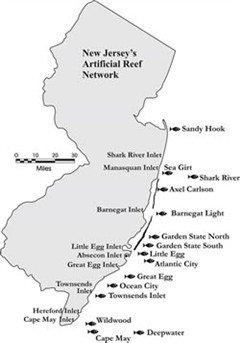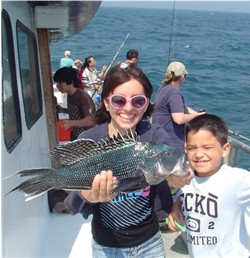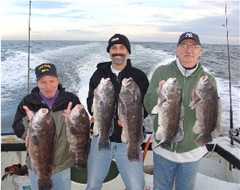| Reefs Draw Unexpected Visitor And an Uninvited One |
|
By Mark Marquez II |
|
Fluke season has slipped away. The fall migration of striped bass and blues is weeks from kicking off. So it’s a great time to go fishing for sea bass, tautog or other bottom dwellers that hug the reefs off New Jersey. Isn’t it? Well, sort of. |
|
Those bottom fish certainly hold along the state’s artificial reefs from now through fall, one of the prime times for anglers to drop down a line and bag plenty. Because bottom fishing now starts to draw the most attention it’ll receive all year, and because the fishing is in danger, now is a good time to help anglers become aware of both the problem and the solution. |
 Map from New Jersey Artificial Reef Program's web site. |
| Yet the reefs were primarily funded by recreational anglers, and were largely intended for recreational fishing. Part of their objective was also to provide economic benefits to the state’s $1.3 billion recreational fishing industry. Bill Figley, a retired biologist from New Jersey fisheries, started the state’s artificial reef program in the 1980s and spent his career building the reefs. He’s at the forefront of a movement to prohibit trapping of any kind on the manmade structures. Earlier this year Figley notified the state that the proliferation of traps on the reefs is increasingly impinging recreational fishing on these structures, he said in a written request for action to New Jersey’s Department of Environmental Protection and its Marine Fisheries Council. The traps or pots impinge on recreational fishing because lines from hundreds to thousands of feet long connect the traps. Anglers fishing the reefs either snag their anchors on the lines, or they drift the areas for fishing and snag their hooks on the pot lines and lose their rigs. A few trap fishermen can set enough trap lines to dominate a reef, denying access to thousands of hook and line anglers for whom the reefs were originally built, Figley said. He noted that a survey estimated that 23,000 feet of pot lines were set on the Axel Carlson Reef in 2005. |
|
 Once sea bass migrate to a reef in spring, 80 percent will remain there the rest of the season, making such fish particularly vulnerable to fishing pressure at the reefs. |
The DEP’s primary source of funding for the reef program comes from a federal excise tax that anglers pay on all sport fishing equipment. Donations also help fund the program, and anglers donate the majority of those funds. The DEP’s New Jersey Reef Plan says that the goal of the reefs was to spread the benefits among as many people as possible. |
Fish and lobster trap licenses were issued to 251 commercial anglers and 26 recreationals last year in New Jersey. The state’s recreational hook-and-line anglers numbered 1.3 million. Most of the state’s reefs were designed for drift fishing. The sites are made up of randomly dispersed concrete chunks, reef balls and such debris, desk-sized structures that are too far apart—maybe five or ten per acre—to effectively fish with hook and line while anchored, he said. Each structure holds a small population of fish that anglers can only catch while drifting on boats randomly across the reef. Anchoring on such small structure, which could quickly wipe out the fish holding there, is practically impossible. The drifting areas were purposely constructed to reduce hook and line catches to hold fish the entire fishing season. Trapping has the opposite effect, Figley explained. Reef fish move around the waters surrounding the structure, looking for food. They come across the traps, which rely on the fish’s natural attraction to structure, and the traps don’t even need to be baited. The traps are there 24 hours a day the entire season. The number of traps that can be set on the reefs is unlimited. |
|
The reefs only occupy 0.7 percent of the sea floor off New Jersey within 30 miles of the coast, so 99.3 percent of the bottom is unaffected by the reefs and remains open to commercial fishing. |
 Tog landed with Outcast Charters from Staten Island. New York and other states have already banned commercial traps on their reefs. |
Fifteen artificial reefs are off New Jersey. Two of the reefs—Sandy Hook Reef and Axel Carlson Reef—are in state waters within three miles from the coast, and the rest are in federal waters. The state’s DEP and Marine Fisheries Council have the right to prohibit trap fishing on reefs within state waters. The DEP, as the permit holder for the reefs, has the sole right to petition the Mid-Atlantic Fisheries Council to grant Special Management Zone (SMZ) status to the reefs in federal waters that would prohibit trapping. New York and Delaware, New Jersey’s neighbors, have already prohibited trapping on the artificial reefs in their state waters. They’re both asking for SMZ protection to ban trapping on the reefs in federal waters off their coasts. South Carolina, Georgia and Florida have already acquired SMZ status to ban trapping on their reefs. Figley and others—including the Recreational Fishing Alliance, the Jersey Coast Anglers Association, the New Jersey Council of Diving Clubs and Reef Rescue—have joined an effort to get New Jersey’s legislature to require the DEP both to prohibit trapping in New Jersey’s waters and petition the Mid-Atlantic Fisheries Council to ban trapping at the reefs in federal waters off the state. The DEP in July proposed to ban the traps from May to October. But previously in February Assemblyman Sean Kean of Monmouth County introduced bill 3986 that would require the DEP to completely ban trapping on the reefs within the state’s waters and require the DEP to petition the Mid-Atlantic Fisheries Council to ban all trapping at the reefs in federal waters off the state. The New Jersey Assembly’s Agriculture and Natural Resources Committee has passed Kean’s bill to ban all traps from the reefs. The bill now awaits a vote by the full assembly, and that could happen any day. Once the full assembly passes the bill, the state Senate will vote. If the Senate passes the bill, Governor Corzine would need to sign it to make it effective. The solution to this problem for New Jersey anglers is to contact your local legislators and express support for this bill. But one of the most important steps is to write to Governor Jon Corzine, State House, P.O. Box 001, Trenton, NJ 08625, requesting SMZ protection for New Jersey’s artificial reefs in both state and federal waters. Let’s get this bill passed and help ensure that fishing along the state’s artificial reefs will still be possible. |
|
* * * |
|
Thank you to Tom Fote from the Jersey Coast Anglers Association for providing much of the information that this article was based on. |
|
|
|





